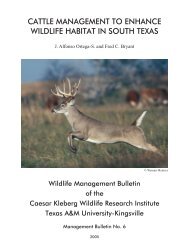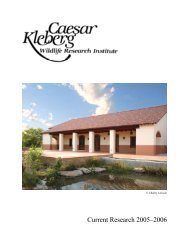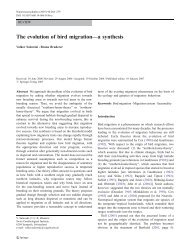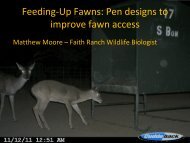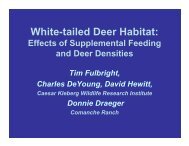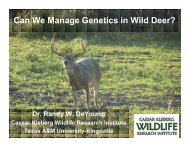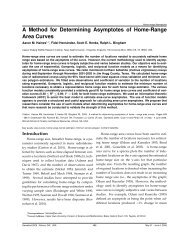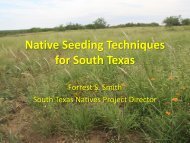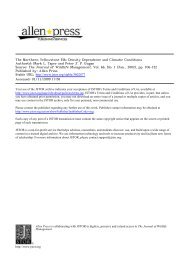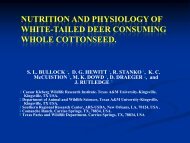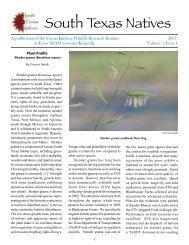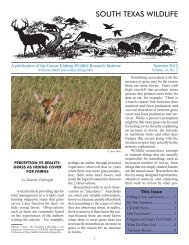The Bobwhite Post - Caesar Kleberg Wildlife Research Institute ...
The Bobwhite Post - Caesar Kleberg Wildlife Research Institute ...
The Bobwhite Post - Caesar Kleberg Wildlife Research Institute ...
You also want an ePaper? Increase the reach of your titles
YUMPU automatically turns print PDFs into web optimized ePapers that Google loves.
<strong>The</strong> <strong>Bobwhite</strong> <strong>Post</strong>A Publication of the Richard M. <strong>Kleberg</strong>, Jr. Center for Quail <strong>Research</strong>Photo by David Hewitt<strong>Caesar</strong> <strong>Kleberg</strong> <strong>Wildlife</strong> <strong>Research</strong> Insitute • Texas A&M University-Kingsville Volume 12, Issue 1 • Spring-Summer 2009From <strong>The</strong> Field: A Biological Approach to Managing<strong>Bobwhite</strong> Harvest on Texas Rangelands<strong>The</strong> northern bobwhite is oneof the most popular gamebirds in the United States.Despite its popularity, this specieshas experienced a well-documentedand precipitous decline in abundanceover the past 80 years. <strong>The</strong> declinehas generally been driven by habitatloss as a result of conversion tounsuitable agricultural practices andurbanization. As available habitatcontinues to decrease in size andincrease in isolation, biologicallyPhoto by Fidel Hernandezjustifiable and sustainable methodsof harvest will become increasinglyimportant components of bobwhitemanagement.Harvest regulations for bobwhitesare based on cultural influences thatexist within recreational hunting.<strong>The</strong>se include both state mandatedbag limits (10–15 birds per day) andself-imposed limitations (limitingharvest per covey to 2–3 birds).Although measures such as these areintended to regulate harvest, they arenot designed to prevent overharvestof bobwhite populations.Harvest theory for bobwhiteshas been evolving over time. Fordecades, the harvest of bobwhites wasconsidered to be simply the taking ofa “doomed surplus”. This conceptarose from observations of quailpopulations in Iowa, Wisconsin, andIllinois. <strong>The</strong> theory suggested that acarrying-capacity threshold existedfor bobwhite populations during thewinter months and, when populationdensities exceeded this threshold,this excess represented a “doomedsurplus” that would inevitablysuccumb to mortality.<strong>The</strong> doomed-surplus concept hasfallen out of favor with researcherswho have instead adopted anotherparadigm of the nature of harvest,the additive-mortality theory. Thistheory suggests that bobwhite harvestwill increase the overall mortality ratewithin a population. However, thisincrease is not 100% additive becausesome of the harvested bobwhitesrepresent individuals which wouldhave died from natural causes. Thus,harvest can only be 100% additiveif the population did not suffer anynatural mortality, which of course isnot the case.<strong>Research</strong> on the nature of huntingsuggests that quail abundanceappears to be the primary arbiterContinued on Page 2
...Memoirs of On a <strong>Wildlife</strong> Point... Biologistare greater than 4 per hour, whichtranslates to a crude density of >1 quail per acre. In contrast, thispast fall, <strong>The</strong> Covey Rise newspapersummary of state-by-state quailreports noted that “…quail hunters inMississippi can expect to find about0.24 coveys per hour of hunting.”This was not a typographical error.Extending the math here means thatit would take a typical quail hunterin Mississippi about 4 hours to finda covey of quail. In South Texas, ittypically takes less than 15 minutesfor a quail hunter to find a covey.THREATS AND CHALLENGES<strong>The</strong> “quail glass” in South Texas isclearly more than half full, while at thesame time the quail glass throughoutmuch of the rest of the U.S. remainshalf empty or worse. While weare indeed seeing something of arenaissance of enlightened quailmanagement in South Texas as wemove into the 21st century, there arenumerous threats and challenges ofwhich we must be aware.One of the biggest threats andchallenges that quail managersface in South Texas are problemsbrought by invasive exotic grasses.<strong>The</strong>se plants, such as guinea grass,buffelgrass, along with Old Worldbluestems, are here to stay and willmost likely continue to increase inboth extent and abundance. Howto manage these grasses, along withnative grasses such as tangleheadthat while allegedly native actecologically like exotics, will be achallenge for years to come. <strong>The</strong>emerging fact that some of thesegrasses—such as buffel, guinea andtanglehead—provide decent nestingcover for bobwhites is a positive.However, the downside seems to bethat the presence of these speciesgreatly reduces—sometimes upto as much as 50% or more—theabundance of food-producing forbsand arthropods.Another important threat toquail in South Texas is landscapefragmentation. Although the politicaldeath of the TransTexas Corridorcould not have come at a better time,landscape fragmentation dynamicsare alive and well in South Texas.Plans continue for the Interstate 69corridor to enlarge existing highwayrights-of-way. Interstate on andoff ramps attract developmentslike picnics attract ants. Neithersituation results in much fun.OPPORTUNITIESDespite the threats and challengesnoted above, it is important tounderstand that quail managementin South Texas represents one of themost important opportunities inwildlife science today. Of course,the research opportunity presentedby the natural laboratory of SouthTexas in which millions of wild quailfunction every year is most obvious.<strong>The</strong> other South Texas quailopportunity is education. A lotof people are doing a lot of goodthings for quail in South Texas.<strong>The</strong> result is a lot of wild quail and,by extension, a lot of high qualityquail hunting. Our collective job asmanagers, scientists, and studentsis to communicate the South Texasquail story to the rest of the world.– Lenny BrennanNon-Profit Org.U.S. <strong>Post</strong>age PaidKingsville, TX 78363Permit # 172<strong>Caesar</strong> <strong>Kleberg</strong> <strong>Wildlife</strong> <strong>Research</strong> <strong>Institute</strong>Texas A&M University-Kingsville700 University Blvd, MSC 218Kingsville, Texas 78363-8202Editor: Fidel Hernandez



